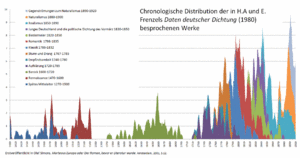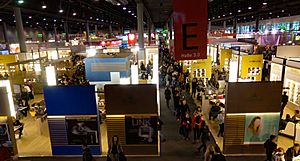German literature facts for kids
German literature is all the amazing stories, poems, and plays written in the German language. This includes works from Germany, Austria, parts of Switzerland and Belgium, Liechtenstein, Luxembourg, and even South Tyrol in Italy. Most modern German literature is in Standard German. But some works also use or are inspired by different German dialects.
German literature has a long history. It goes all the way back to the Middle Ages. Famous early works include the Hildebrandslied and the epic poem Heliand. The Baroque period (1600-1720) was a very creative time. Later, movements like the the Enlightenment and Sensibility brought new ideas. Writers like Johann Wolfgang von Goethe and Friedrich Schiller led the Sturm und Drang and Weimar Classicism movements. German Romanticism was also very important in the late 1700s and early 1800s.
The Biedermeier period (1815-1848) saw new styles in literature and art. During the Nazi time, some authors had to leave Germany. Others faced strict rules about what they could write. Many German-language authors have won the Nobel Prize in Literature. These include famous names like Thomas Mann, Hermann Hesse, Günter Grass, and Peter Handke.
Contents
Periods of German Literature
Thinking about German literature often means looking at different time periods. These periods help us understand how writing styles and ideas changed over time. The older periods, like the Middle Ages, cover hundreds of years. More recent periods might only last a decade or two.
Here are some of the main periods:
- Medieval German literature
- Old High German literature (750–1050)
- Middle High German literature (1050–1350)
- Early Modern German literature
- Humanism and the Protestant Reformation (1500–1650)
- Baroque (1600–1720)
- Enlightenment (1680–1789)
- Modern German literature
- 18th- and 19th-century German literature
- Empfindsamkeit / Sensibility (1750s–1770s)
- Sturm und Drang / Storm and Stress (1760s–1780s)
- Weimar Classicism (1788–1832)
- German Romanticism (1790s–1880s)
- Biedermeier (1815–1848)
- Young Germany (1830–1850)
- Poetic Realism (1848–1890)
- Naturalism (1880–1900)
- 20th-century German literature
- Expressionism (1910–1920)
- Dada (1914–1924)
- New Objectivity (Neue Sachlichkeit)
- Well-Known Writers of the 20th Century
- 1933–1945
- National Socialist literature
- Exile literature (authors who left Germany)
- 1945–1989
- Post-war literature (1945–1967)
- Group 47
- Holocaust literature
- Contemporary German literature (1989–present)
- 18th- and 19th-century German literature
Medieval Literature
Medieval German literature includes works written in Germany during the Middle Ages. This period started around the time of the Carolingian dynasty. It ended around the Protestant Reformation in 1517.
Old High German
The Old High German period lasted until about the mid-11th century. The most famous work from this time is the Hildebrandslied. It is a short heroic poem. Another important work is the Heliand, which tells the life of Christ as a heroic story.
Middle High German
Middle High German literature began in the 12th century. From 1170 to 1230, there was a "golden age" of medieval German literature. This was when Minnesang became popular. Minnesang was a type of love poetry, similar to French courtly love songs. Walther von der Vogelweide was a very important Minnesang poet.
During this time, many important courtly romances were also written. These stories, like Parzival by Wolfram von Eschenbach, often featured Arthurian legends. They were inspired by French stories. Heroic epics were also popular, like the Nibelungenlied. These stories were often based on old Germanic tales.
The Middle High German period usually ends around 1350. Works from the late 14th and early 15th centuries are a mix of old and new styles. These include The Ring (around 1410) and poems by Oswald von Wolkenstein. The Volksbuch (chapbook) tradition also started in the late 1400s.
Early Modern Period
German Renaissance and Reformation
This period saw important changes in Germany. The Protestant Reformation was a big event led by Martin Luther. He translated the Bible into German. This helped shape the German language. Other writers from this time include Sebastian Brant and Thomas Murner.
Baroque Period
The Baroque period (1600 to 1720) was a very creative time for German literature. Many writers wrote about the terrible experiences of the Thirty Years' War. Grimmelshausen's Simplicius Simplicissimus was a famous novel from this time. It tells the adventures of a young, innocent character. Writers like Andreas Gryphius also wrote serious plays called Trauerspiele.
18th Century
The Enlightenment
The Enlightenment was a time when people focused on reason and new ideas. Important thinkers and writers like Johann Gottfried Herder, Immanuel Kant, and Gotthold Ephraim Lessing were part of this movement. They wrote about philosophy, society, and art.
Sensibility
The Sensibility movement (1750s–1770s) focused on feelings and emotions. Key writers included Friedrich Gottlieb Klopstock and Sophie de La Roche. This period ended with Goethe's very popular novel, The Sorrows of Young Werther (1774).
Sturm und Drang
Sturm und Drang (meaning "Storm and Stress" or "Storm and Urge") was a movement from the late 1760s to early 1780s. It emphasized strong emotions and individual freedom. Writers wanted to break away from strict rules. Johann Wolfgang von Goethe was a key figure in this movement. He and Friedrich Schiller later moved on to Weimar Classicism.
19th Century
German Classicism
Weimar Classicism was a cultural movement led by Johann Wolfgang von Goethe and Friedrich Schiller. It lasted from about 1786 to 1805 (or 1832, depending on how you define it). This period focused on balance, harmony, and the ideals of ancient Greece and Rome.
Romanticism
German Romanticism was a major movement in the late 18th and early 19th centuries. Unlike English Romanticism, German Romanticism often included humor and wit. Early Romantics tried to combine art, philosophy, and science. They looked back to the Middle Ages for inspiration. Later, they explored the tension between everyday life and the magical world of imagination.
Some important Romantic writers include E.T.A. Hoffmann, Friedrich Hölderlin, and Novalis (Friedrich von Hardenberg).
Biedermeier and Vormärz
The Biedermeier period (1815–1848) was a time of peace and quiet. It focused on home life and simple joys. Poets like Annette von Droste-Hülshoff and Eduard Mörike are typical Biedermeier writers.
Young Germany was a group of writers (around 1830-1850) who wanted social and political change. They were a youth movement. Important members included Karl Gutzkow and Heinrich Heine.
Realism and Naturalism
Poetic Realism (1848–1890) focused on showing life as it really was. Writers like Theodor Fontane and Gottfried Keller wrote detailed stories about everyday people and places.
Naturalism (1880–1900) went even further. It tried to show life in a very scientific and objective way. Gerhart Hauptmann was a leading Naturalist writer.
20th Century
1900 to 1933
This period saw many new artistic movements.
- Expressionism (1910–1920) showed strong emotions and inner feelings.
- Dada (1914–1924) was an anti-art movement that challenged traditional ideas.
- New Objectivity (Neue Sachlichkeit) focused on a more realistic and cool style.
Well Known Writers of the 20th Century
One very famous writer was Franz Kafka. His novels, like The Trial, explore themes of confusing rules and feeling alone. His unique style led to the word "Kafkaesque."
Nazi Germany
During the Nazi regime (1933–1945), many authors faced challenges. Some had to leave Germany and live in exile (Exilliteratur). Others stayed but had to deal with strict censorship (inner emigration).
Famous authors who went into exile include Bertolt Brecht, Thomas Mann, and Stefan Zweig. Those who stayed but faced censorship included Erich Kästner and Ernst Jünger.
1945 to 1989
After World War II, German literature explored the war's impact.
- In West Germany, writers like Heinrich Böll and Günter Grass wrote about post-war life. Group 47 was an important group of writers.
- Holocaust literature, by authors like Paul Celan, dealt with the horrors of the Holocaust.
- In East Germany (German Democratic Republic), writers like Christa Wolf and Anna Seghers explored life under communism.
- Writers from Austria and Switzerland also became well-known, such as Ingeborg Bachmann and Friedrich Dürrenmatt.
21st Century
Today, German literature continues to grow and change. Many new poems are published in literary magazines.
- Science-Fiction and Fantasy writers like Frank Schätzing and Wolfgang Hohlbein are popular.
- Pop Literature explores modern youth culture.
- Migrant literature by authors like Wladimir Kaminer tells stories from different cultural backgrounds.
- Many new novelists are writing today, including Daniel Kehlmann and Jenny Erpenbeck.
Nobel Prize Laureates
The Nobel Prize in Literature is a very important award. German-language authors have won it 14 times. This is the second highest number of wins, tied with French authors.
Here are some of the German-language writers who have won the Nobel Prize:
| Thomas Mann (1875–1955) |
Hermann Hesse (1877–1962) |
|---|---|
- 1902 Theodor Mommsen
- 1908 Rudolf Christoph Eucken
- 1910 Paul Heyse
- 1912 Gerhart Hauptmann
- 1919 Carl Spitteler (Swiss)
- 1929 Thomas Mann
- 1946 Hermann Hesse
- 1966 Nelly Sachs
- 1972 Heinrich Böll
- 1981 Elias Canetti (Bulgarian, later British)
- 1999 Günter Grass
- 2004 Elfriede Jelinek (Austrian)
- 2009 Herta Müller (Romanian by birth, later naturalized in West Germany)
- 2019 Peter Handke (Austrian)
See also
 In Spanish: Literatura en alemán para niños
In Spanish: Literatura en alemán para niños
- Goethe-Institut
- German-speaking Europe
- Swiss literature
- Austrian literature
- List of German-language authors






